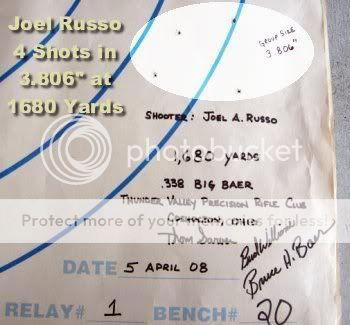Thanks for the kind words FEENIX, I've been fortunate to have shot some good groups at extended ranges.
The topic at hand, can be a controversial issue indeed. A short range benchrest rifle, with a custom action that has a longer than normal tennon, typically will not benefit from chamber bedding. The original poster is shooting a .300 RUM with a long heavy barrel. I may be wrong to assume, but I'll assume, that he is not intrested in shooting short range benchrest competition. I'm pretty sure he is building hunting rifle capable of taking game at reasonable distances. My experience is that these types of builds will benefit for a chamber bed.
This brings me to the bedding block discussion.... Bedding blocks generally enable a rifle to be more consistent, but not necessarily more accurate. This is the same concept for a chamber bedded barrel. The bedding supports the barrel, and deters movement at the critical barrel receiver junction.
Try holding a 32" long, 8lb barrel by 1" at the end, and see how long you can hold it in the horizontal position...
The stock in the picture that I posted, was from a .338 Lapua build, with a long heavy barrel.
I never shot short range benchrest competitions with small calibers, but I have shot long range and extended range competitions with large calibers. My experience in this discipline is that these builds benefit from chamber bedding.
Hey, just my .02...

